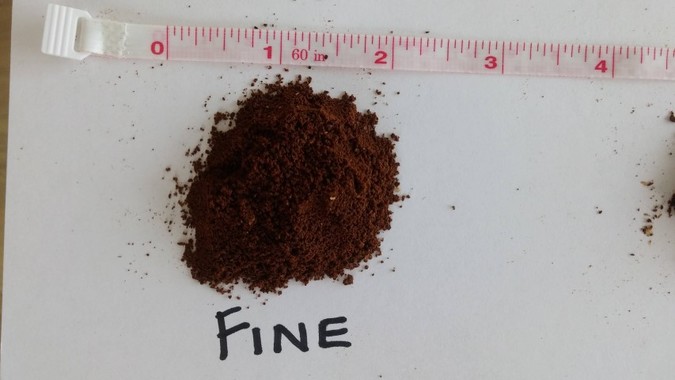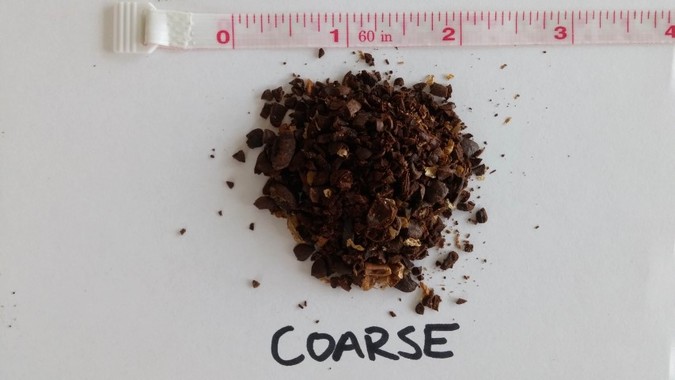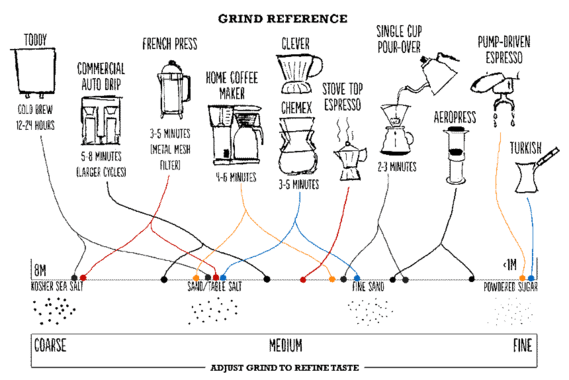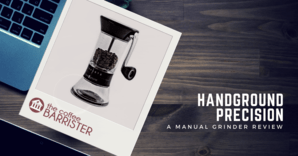
Grinding coffee correctly is probably the most important step in brewing coffee. If you use the wrong grind size for your specific brewing method, then you might produce coffee that’s very muddy or very weak. With correct grinds, you’ll be able to make a cup of coffee that emits fresh aroma and bright tastes.
This guide will go through what’s coffee grinds and help you find the best grind size depending on what you’re brewing.
Not sure if you want to grind your own coffee? Find out in this coffee grinder guide.
Coffee Grinding 101
When coffee beans are grounded, they become coffee grinds. Normally, they are produced by a coffee grinder. If you go to a local, specialty coffee hop to buy beans, the barista behind the counter might ask you ‘is it for paper of metal filter’?
When you grind your own coffee, consistency is key! You want to make sure the coffee grinds are both consistent and even. This means the Wal-Mart blade grind that slices the beans randomly would not cut it, you’ll need a more sophisticated burr grinder instead. I personally use a Capresso Infinity, it produces consistent grind and easy to use.
Types of Coffee Grinds
Now that we know a little bit more about grinding coffee, the next part is learning what type of grind is used for different types of brew. Coffee grinds are classified into 3 general categories depending on its size; fine, medium, or coarse. However, it’s more appropriate if we look at it from a spectrums point of view. This is because consumers tend to make tiny adjustments to the grind size to cater to their specific tastes.
For simplicities sake, I’ll concentrate on the 3 main categories, where I’ll show you what they look like and go through them in more detail – starting from finer end all the way to coarser.
We’ll go through this section in more detail starting from the finer end all the way to coarser.
Fine Grind
At the finest end of the spectrum, there’s the extra-fine coffee grind. They’re extremely fluffy and are widely known to be used in making Turkish coffee. Turkish coffee is made by pouring hot water directly over the grinds and pushing them away with a spoon. Cowboy coffee, a less well-known brew that originated in America…also uses coffee grinds at this level of fineness.

Fine grinds are next in line, they’re normally quite fluffy and smooth. If you’ve ever want to make your own espresso-based drink like a latte, cappuccino, or mocha…then fine grinds is what you need! It’s better to use fine grinds because there are less air pockets when you tamp them in the portafilter. This helps in creating water pressure when the espresso machine propels 1 – 2oz of hot water through the grind beds.
Espressos probably require the most consistent coffee grinds out of all types of brew. When I worked as a barista, we would maintain our coffee grinder regularly to make sure everything is working and that it’s producing perfectly consistent grinds. You can find out more about espresso making and importance of grind here.
Medium Grind
Next up are medium grinds, they normally range from the size of sand all the way to table salt. Most brewing techniques uses some sort of medium grinds, whether it’s medium-fine or medium-coarse. As such, it’s arguably the most commonly used grinds.

Pre-ground coffee in local supermarkets is usually medium grind. The reason is that medium grind works best for brews that use paper filter. Suppliers know that the mass market uses an old, reliable Mr. Coffee brewer, so they match the demand by selling medium grinds.
If you’re planning to use a drip brew, there are both advantages and disadvantages in using pre-ground coffee. Normally, grinds produced by commercial grinders will be very consistent, but they won’t be as fresh – you must use up your coffee grinds a week after grinding or it’ll go stale!
As for medium-fine grinds, they’re best for small, single use pour-overs, such as the Hario V60. This type of grind is also great for siphon brewers and vacuum pots. Lastly, for medium-coarse grinds, they’re use in a Chemex.
Coarse Grind

French press is one of the most popular brewing methods in the world! It uses a pot and a plunger that pushes coffee grinds to the bottom. It’s important to keep it coarse because if not, the grinds will just go through the plunger and ruin the coffee. For French press, Stumptown Coffee recommends using coffee grinds that’s the size of large breadcrumbs.
The last type of grind on the other end of the spectrum is extra-coarse grinds. This type of grind is most commonly used for cold brew. This is where a double-shot is drip brewed over ice.
Grind Size Reference [for Common Brewing Methods]
- Turkish: Use extra-fine grinds that’s around the size of powdered sugar.
- Espresso: Use fine-grinds; similar to Turkish but slightly coarser.
- AeroPress: There are many recipes that uses a wide range of grinds. However, majority uses grind in the fine to medium range.
- Pour-Over: Medium fine works best.
- Drip-Brew: For paper filter, use medium sized grinds. If it’s metal filter, go for medium-coarse instead.
- Chemex: Use medium-coarse coffee.
- French Press: Use coarse grinds so the coffee won’t go through the mesh in the plunger pot.
Overall, grinding process is an important morning routine to me. It doesn’t feel right anymore if I don’t brew a cup of quality coffee every morning. With the guidelines I’ve laid out here, it should help you on your way to improve your morning coffee experience.
I’ll end this article with this image, which summarizes the grind range to consider based on the brew type you use.

Grind Reference – The Coffee Roaster





